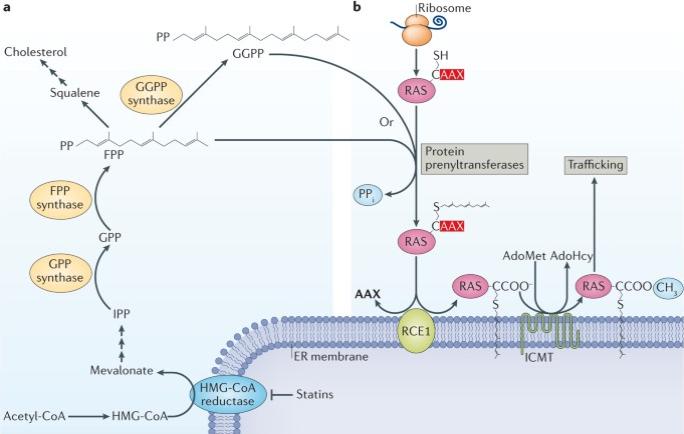Prenylation Analysis Service
Protein prenylation stands as a pivotal protein lipid modification, governing the localization and activity of various proteins crucial for biological regulation. At Creative Proteomics, our expertise extends to high-quality prenylation analysis services. We specialize in the identification, quantification, and characterization of prenylation, delivering valuable insights for your protein research initiatives.
What is Prenylation
Protein prenylation is a crucial PTM that entails the addition of lipid groups—farnesyl or geranylgeranyl moieties—to specific cysteine residues near the C-terminus of proteins. Prenyltransferase enzymes catalyze this modification, serving as a vital determinant of protein localization and function within the cell. Prenylated proteins typically associate with cellular membranes, leveraging their lipid modifications to facilitate interactions with other proteins and membrane structures.

Fig.1 Schematic of prenylation (Wang, M.; Casey, P. 2016)
During prenylation, the addition of lipid groups—farnesyl and geranylgeranyl—comprises 15-carbon and 20-carbon isoprenoids, respectively. This modification enhances the hydrophobicity of the protein, facilitating its anchoring to cellular membranes. The choice between farnesylation and geranylgeranylation is dictated by the specific prenyltransferase enzyme and the sequence context around the target cysteine. Notably, this lipid modification is reversible, allowing for dynamic regulation of protein-membrane interactions. Prenylation is commonly associated with small GTPases, such as Ras, Rho, and Rab proteins, pivotal players in cellular signaling and membrane trafficking.
Applications of Prenylation Analysis
- Cell Signaling Study
Protein prenylation is pivotal for various cellular processes, including signal transduction, vesicular trafficking, and cytoskeletal organization. - Disease Research
Dysregulation of prenylation is implicated in diseases like cancer and neurodegenerative disorders. In cancer, mutated forms of Ras proteins often exhibit aberrant prenylation, contributing to uncontrolled cell growth. Consequently, prenylation has emerged as a target for therapeutic interventions. - Drug Development
Inhibitors of prenyltransferase enzymes, such as farnesyltransferase inhibitors (FTIs) and geranylgeranyltransferase inhibitors (GGTIs), have been explored as potential anti-cancer drugs. Understanding the principles of protein prenylation provides insights into the molecular mechanisms underlying diseases and offers avenues for developing targeted therapies to modulate cellular processes.
Our Service
Creative Proteomics has advanced protein detection technologies and can provide customized services to researchers and scientists to help them reveal the complexity of PTM using powerful mass spectrometry technologies. Our services are thoughtful and detailed and the process of prenylation analysis service is as follows:

Fig.2 Prenylation analysis workflow
- Sample Preparation
Proper extraction and preparation of proteins from biological samples to ensure preservation of prenylated proteins. - Prenylation Enrichment
Enrichment techniques are employed to isolate prenylated proteins or peptides. This step is crucial as prenylation modifications are often present in low abundance compared to unmodified proteins. - Detection
WB, protein microarrays and LC-MS/MS are powerful tools for the identification and quantification of prenylated peptides, and they provide detection information that facilitates a comprehensive analysis of prenylation. - Bioinformatics Analysis
Advanced bioinformatics tools are used to analyze data, identify prenylated peptides, and map these modifications to protein sequences. - Result Delivery
After professional data analysis, we deliver results quickly and consistently.
Creative Proteomics brings a wealth of experience to the field of protein research. Our comprehensive services and products cover the entire spectrum of utilizing suitable and efficient gateways. Utilizing our proprietary platform, we have successfully implemented many proteomics research projects. If you are interested, please contact us for more information and a quote.
Reference
- Wang, M.; Casey, P. Protein prenylation: unique fats make their mark on biology. Nature Reviews Molecular Cell Biology. 2016, 17(2): 110–122

